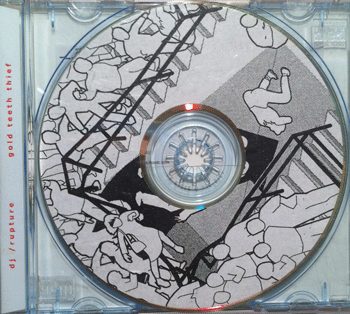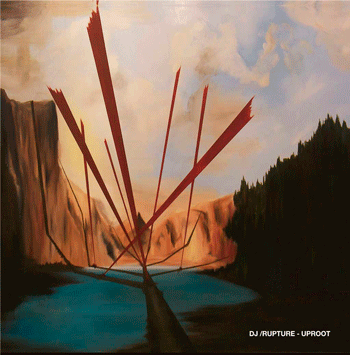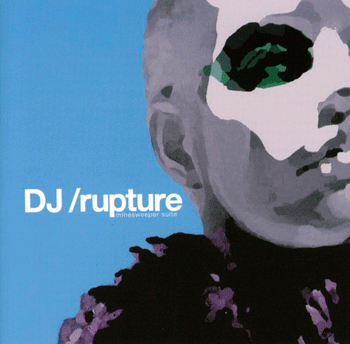EPIPHANY SCHOOL: free DJ /rupture mixes
آموزشگاه ظهور و تجلی : آمیختن گسیختگی/ دی جی رایگان
http://www.negrophonic.com/dj-rupture-mixes-free-download/
خلاقیت ارائه موسیقی در فضا و مکانی نوین : پیمان پایدار

Yeah, I have tinnitus by now but it’s not so bad.. I’ve DJed a lot of parties and made a lot of mixtapes over the years… And now you can listen and download most of them right here. The best place to begin is 2001’s game-changing live 3-turntable mix, Gold Teeth Thief. This influenced a lot of people & opened many ears; over a decade later, the world sounds a lot more like I was hearing/blending it back then.
Here’s a list of most of my mixes in chronological order for free download as V0 mp3s. (Hit Discogs for tracklists.) After the list you’ll find cover art & brief commentary on each one, presented in a ‘suggested listening’ order. If my course through the world of sound has moved you over the y/ears, please consider a donation. You can also find me on Twitter, Instagram, or sign-up for my newsletter.
EPIPHANY SCHOOL – over 8 hours of Rupture mixes from 2001-2012!
DJ /rupture – Gold Teeth Thief (2001) mp3 | info
DJ /rupture – Minesweeper Suite (2002) mp3 | info
DJ /rupture – Bidoun Sessions (2004) mp3 | info
DJ /rupture – Low Income Tomorrowland (2005) mp3 | info
DJ /rupture – Secret Google Cheat Codes (2007) mp3 | info
DJ /rupture – Porque Soy Sonidero Y Voy A Muchos Lugares (2008) mp3 | info
DJ /rupture – Uproot (2008) mp3 | info
DJ /rupture – Cumbia Mix for BBC1 (2009) mp3 | info
DJ /rupture & Matt Shadetek – Solar Life Raft (2009) mp3 | info
DJ /rupture & Sharifa Rhodes-Pitts – Harlem Is Nowhere (2011) mp3 | info
DJ /rupture – Change The Mood (2012) mp3 | info
DJ /rupture – Sunset Park Rent Strike mix (2012) mp3 | info
DJ /rupture – Minesweeper Suite (2002) mp3 | info
DJ /rupture – Bidoun Sessions (2004) mp3 | info
DJ /rupture – Low Income Tomorrowland (2005) mp3 | info
DJ /rupture – Secret Google Cheat Codes (2007) mp3 | info
DJ /rupture – Porque Soy Sonidero Y Voy A Muchos Lugares (2008) mp3 | info
DJ /rupture – Uproot (2008) mp3 | info
DJ /rupture – Cumbia Mix for BBC1 (2009) mp3 | info
DJ /rupture & Matt Shadetek – Solar Life Raft (2009) mp3 | info
DJ /rupture & Sharifa Rhodes-Pitts – Harlem Is Nowhere (2011) mp3 | info
DJ /rupture – Change The Mood (2012) mp3 | info
DJ /rupture – Sunset Park Rent Strike mix (2012) mp3 | info

DJ Rupture – Gold Teeth Thief (2001)
The overwhelming response to this mix changed my life. Countless fans have told me that it changed their ideas about music, too. I posted this online for free in early 2001 and by the end of the year there were hundreds of thousands of downloads, and write-ups in places like VIBE, where Jon Caramanica’s 4-star review called it: “A stunning, globe-trotting, three-turntable mix… bumping, brash, and without borders.” You can read more about Gold Teeth Thief in my n+1 essay from 2008.
——————-

DJ Rupture – Uproot (2008)
This is my most approachable mix — probably because it’s the only one I’ve ever licensed 100% legally…
From Pitchfork’s Best New Music review: “While Uproot feels every bit as purposeful as those earlier mixes, it achieves that goal though different means. Musically, it’s far more subdued and spacious; the lacerating swathes of digital noise have been subbed out for tracks that favor lonely, clattering rhythms, yawning sub-basslines, and displaced vocals. Like a lot of his contemporaries, Rupture has clearly gravitated towards dubstep over the past few years, and Uprootshows his selection skills in that space are as impeccable as they are elsewhere. . . Clayton’s selections are generous and far-reaching, and build a pretty compelling case for dubstep as the most creatively robust genre in electronic music right now.”
Be sure to check out Gary Breslin’s video piece for Uproot. It’s incredible. Matt Shadetek & I produced the instrumental beat “Reef” that you hear in the video.
——————-
DJ Rupture – Minesweeper Suite (2002)
This is the epic one. Will Hermes’ Entertainment Weekly review sums it up nicely: “If Robert Rauschenberg were a DJ obsessed with the global black experience, his records would sound like this.Minesweeper flexes much like /rupture’s bootleg-style MP3 hit from last year, Gold Teeth Thief, spinning Timbaland stutter snares, North African chants, ruffneck dance-hall reggae MCs, videogame drum ‘n’ bass rolls, and noise blasts into an ever-mutating mix. Even when things lurch into chaos, there’s still something to hold onto — a fractured rhythm inside the distortion, a steady vocal melody above the seasick beats. And remember: With /rupture, you always get more samples than you paid for. ONE FOR THE DIVAS Public-radio piano queen Norah Jones turns up, before morphing into Sade, Soul II Soul’s Caryn Wheeler, and too many others to count.”
——————-
DJ /rupture – Porque Soy Sonidero Y Voy A Muchos Lugares (2008)
The title translates to ‘Because I’m A Soundboy And I Go To Many Places’. You can hear cumbia and other so-called tropical sounds creeping into my set in a more overt way on this one, it’s a transitional moment.
——————-
DJ /rupture – Bidoun Sessions (2004)
Shoutouts to Shehab, who brought over Mutamassik and I to DJ in Dubai. This was in 2003-4, back when Bidoun was an event production crew (& not yet a lush print magazine headquartered in NYC). He asked each of us to do a 30min promo mix, which we later compiled on a split CD. Here’s my set. Vocals in the beginning come from the extraordinary Moroccan band Nass El Ghiwane. Boomkat wrote, “World-class and world-conscious. Rupture’s blazing half-hour bidoun session fuses hot new orientalist dancehall and battle-grade hiphop with arabic vocals and instrumentation, soul divas, and a dusting of break-core grit.”
——————-
DJ /rupture – Low Income Tomorrowland (2005)
Remember 2005? Grime, crunk, dancehall, plus some Berber horns in 6/8 at the beginning to go with dead prez. It was that kind of year. Low Income Tomorrowland was first available on the mighty Lemon-Red blog then later sold on a CD with 30minutes of audio (that’s what’s here) & an additional 90 minutes of data MP3s from some radio mixes I did in Germany. LIT is the last mix of mine to use any breakcore/d&b (I think).
This fan video goes above and beyond the standard ‘black kids dancing’ oogle-vid: their flipped Big Freedia bounces in Sizzla-karaoke mode as post-GIF edits accentuate the frenzy of the blend.
——————-

DJ /rupture & Sharifa Rhodes-Pitts – Harlem Is Nowhere (2011)
“Once, a group of tourists were asked what came to mind when they heard the word “Harlem”: some said “music” and the others said “riots.” The connection between the two is a story for another time. This Harlem mixtape is born of our own free associations: For Rupture, Francophone songs sold by scowling Africans along 116th, or old soul and R&B memories being hawked alongside the now-thing bootlegs across 125th; for Sharifa, church sounds tumbling onto the streets and distorted strains of jazz heard from a boombox carted around by a wandering neighbor.”
— Go here to keep reading the introduction that Sharifa Rhodes-Pitts& I wrote for Harlem Is Nowhere, a collaborative mix which formed part of DOMUS magazine’s ‘City Mixtapes’ series.
Chase Hoffberger has a great review: “Though it was Ralph Ellison who first coined the phrase “Harlem is Nowhere” in 1948, DJ /rupture’s beautifully complex mix made with writer Sharifa Rhodes-Pitts lends itself closer to Toni Morrison’s freeform, Harlem-set Jazz. Like Harlem’s beloved musical pastime, “Harlem is Nowhere” carries a loose, meandering narrative, one pulled from Rhodes-Pitts’ book of the same name and read poignantly by the author. The music – helmed by /rupture, who with Matt Shadetek runs Brooklyn’s Dutty Artz – is divine. A lead of Shabazz Palace’s smacking “Kill White T;” Gil Scott-Heron’s stripped “New York Is Killing Me;” a scratchy cut of Rev. Johnny L. Jones’ “I Got Drunk for the Lord/Train is Moving On;” this is the Harlem landscape: chaotic, spiritual, heated and beautiful. That’s never captured better than on Jennie C. Jones’ “You Make Me Feel Like 100 Billie Holiday Songs,” a swirling, sprawling and elegantly maddening amalgamation of the Harlem Lady’s many voices.”
——————-
DJ /rupture – Secret Google Cheat Codes (2007)
893 & I made a non-standard website that formed the ‘tracklist’ to this mix, which I accidentally let get deleted. I still regret that! Moral of the story: Secret Google Cheat Codes Are Real. This half-hour mix was available on a split mix CD.
——————-
DJ /rupture – Cumbia Mix for BBC 1 (2009)
In late 2008, BBC presenter Rob Da Bank asked me to put together a cumbia mix for BBC 1 radio — the first-ever cumbia set they aired! Here are the results. (I released a version without radio drops as “K-K-Kumbia”, artwork above). I’d been digging these sounds for several years then and had recently published a feature on cumbia in The Fader.
——————-
DJ /rupture & Matt Shadetek – Solar Life Raft (2009)
Matt Shadetek & I produced about a third of the music in this mix. A New York City thing. Chillin’ in Rome with my friend Sara Taigher, I explained the whole ‘kids grilling octopii & making beats on cellphones in a drowned NY 40 years in the future’ vibe that Matt & I were on — which can be read in the short story in the physical liner notes! — and she instantly got it, then upped the ante. Witness the results in her stunning video below:
——————-
DJ /rupture – Change The Mood (2012)
These last two mixes (for now) are both special 2012 one-offs. Change The Mood snapshots what my party mixes were like in summer 2012 — it’s only 23 minutes long, but packs in a lot. I did this mix to help promote a fundraiser club night for ‘Beyond The Block‘, a community-minded social justice oriented street party we threw in Brooklyn. Change The Mood starts off with a classic Lauryn aca… The ‘Arabic’ sounding beats you hear under Mobb Deep then Dani Shivers and later with auto-tune vox are from Cairo — earlier this year I spent time with DJ Figo, Amr 7a7a, and other incredible young musicians in Egypt which you can read about in the feature article I wrote on their ‘festival’ scene for The Fader.
——————-

Uproot by Jace Clayton review – exploring a world of sound with DJ /rupture
بررسی 'ریشه کن کردن' توسط جیس کلیتون - کاوش در جهانی از صدا با دی جی/ گسیختگی
https://www.theguardian.com/books/2016/oct/27/uproot-travels-in-21st-century-music-and-digital-culture-jace-clayton-review?CMP=share_btn_tw
From snatches of songs on phones, to Cairo’s traffic noise, to dancehall samples of Careless Whisper ... this is a set of witty reports from the 21st-century musical underground.
از قاپیدن آهنگهائی (بر روی) گوشی های تلفن ، تا سر و صدای ترافیک در قاهره، تا نمونه ای از نجوای بی دقت سالنهای رقص ... این مجموعه ایست از گزارش شوخی وار از موسیقی زیر زمین قرن بیست و یکم .
I
n 2011, the British-born, Los Angeles-based writer Simon Reynolds published a much debated book called Retromania, which examined pop music’s growing devotion to revivals, reissues and reunions. Wasn’t this phenomenon, he speculated, “another facet of the recline [sic] and fall of the West”? If so, then perhaps innovation in music and sound, together with the spirit of “rebel yell”, was now more likely to emerge from China, Africa and Latin America – parts of the global south where “popular energies and desires will be stoked that come into friction with existing political structures and social norms, producing sparks and possibly conflagrations”.
One of the people best placed to cast more light on these tantalising vistas is Jace Clayton, otherwise known as DJ /rupture and once described by the influential music magazine Wire as a “pan-global, post-everything superhero ”. In his DJ sets and on his popular Mudd Up! show on the American WFMU radio station, he routinely meshed Jamaican dub, Japanese noise, south London jungle and Egyptian mahraganat – electronic music born of Cairo’s slums. Harvard-educated, a writer for art journals such as Bidoun and Frieze, he’s also responsible for conceptual art projects such as Sufi Plug Ins, for which he created a series of programs that readjusted and retuned western sounds according to north African quarter-tone scales. Essentially, the goal was to orientalise the technology of late capitalism.
Uproot, his first book, is a meditation on how sounds are made, circulated and used by people around the world. It also chronicles an era at the beginning of the 21st century when the ecology of music – the material on which it was pressed, the shops where it was sold, the money made by its creators – had become mostly nonexistent. But Clayton was too young to spend all his time bemoaning past epochs; he self-released a frenetically polycultural mixtape, Gold Teeth Thief(2003), made it freely available online, and parlayed the attention it received into a still-intense schedule of air-mile-racking DJ sets.
The book is a travelogue of sorts. Here he is in Zagreb, Dubai and Osaka. Here he is in Lebanon using Bluetooth to grab some of the tunes his Adidas-tracksuited cabbie is playing on his mobile phone. Here he is in Monterrey, north-east Mexico, going past emo kids and reggaeton fans on his way to hear thundering tribal guarachero played by a DJ behind whom is projected a Harry Potter movie. And here he is in Kingston where he is gobsmacked to hear George Michael’s “Careless Whisper” dropped by dancehall DJs.
Among the Berbers in Morocco, he hangs out with local singers, listening to them make showy use of Auto-Tune, the audio processor that shifts pitches – made famous by Cher in her single “Believe”. He ponders the popularity of Whitney Houston-style melisma across the Maghreb, from “bawdy folksingers whose throats have been burned by a lifetime of whisky, to honey-voiced Koranic reciters, who ‘sing’ the Koran magnificently yet consider all music to be sinful”.
In places like these, there is groove and grit, tradition and reinvention. (Closer to home, in Brooklyn’s Sunset Park, an especially well-textured section of the book concerns the Mexican sound-system parties he attends.) Clayton isn’t looking for undiscovered music or acoustic authenticity; today, he argues, physical instruments and spaces to rehearse, along with dexterity, technique and muscle memory, are less important than computer access, “although, in a pinch, a PlayStation or smartphone will do”. Rather, he’s fascinated by “audio terroir”, the ways in which environments – even tough, unprepossessing ones – can gestate and nurture novel sounds.
Enemies of promise are often lurking. DJs and producers scour the planet looking to extract resources from previously untapped areas, plundering emergent scenes for grabby rhythms and samples. In one excellent riff, Clayton contrasts the daring, almost violent collage techniques of 1920s dadaists and Soviet montagists with the “boring, tidy, toothless” ways in which the copy, cut and paste functions on a keyboard allow data to be moved around a screen today. Even more insidious are the sports and soft drinks companies that increasingly seek to forge brand-enhancing relationships with “underground” culture. “Our sounds and struggles activate their environs as places of heightened meaning.”
Uproot is witty and nuanced rather than sloganeering, and shot through with the immersive research and hard‑earned access to key, sometimes evasive, figures that would be the envy of any Ivy League anthropologist. But Clayton is at his most suggestive when, true to his title, he discusses the relationship between the movement of sounds and of migrant bodies. In Barcelona he has a friend, Mark, an undocumented African musician who lives out a kind of “Mediterranean gothic”, squatting in an ex’s apartment, unable to use electric lights after dark for fear of alerting others to his presence. In Casablanca, he heads to a market where the “inorganic tang of injection-molded plastics off-gassing complex, probably carcinogenic, polymer molecules mingles with sweat and diesel exhaust”. Here, as in much of the world, he says, the sellers of cheap, Chinese-run, factory-produced plastic are also the sellers of bootleg, MP3-stuffed CDs.
Indeed, when Clayton talks about techniques such as transcoding and compressing – the art of squeezing recorded music into easily exportable and copyable packets of data – he could almost be talking about the journeys of refugees and migrants: “This is the sound of files that have survived patchy connections and erroneous metadata, straddling pirate servers and shaky Bluetooth transfers and YouTube rips, evading spam filters en route to Russian wares sites, to end up on a desktop or in some web video accompanied by an equally messed-up JPeg.” Foreign sounds, like foreigners themselves, invade. But Clayton, like many club goers, embraces the idea of music as a zone of mutation and adaptation, of new rhythms as thrillingly contagious, of the dancefloor as a place of both affirming and redefining community.
• Uproot is published by FSG Originals.









No comments:
Post a Comment